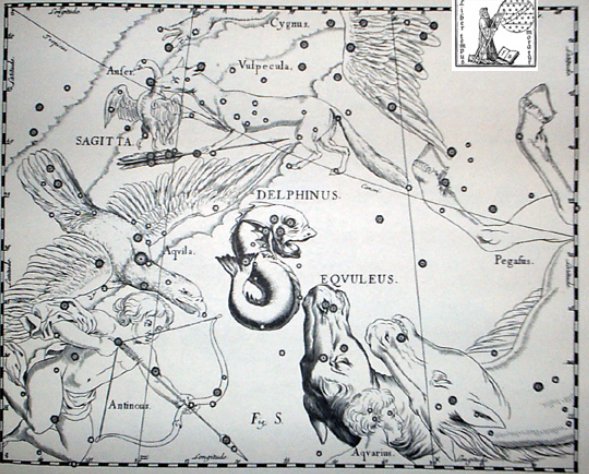Below is an overview of the Hindu view so far (although Denebola, β Leonis) does not arrive until early in line Cb7:
| ARIES: |
| 1 |
Ashvini |
β and γ Arietis |
Horse's head |
27 |
| wife of the Ashvins |
Sheratan and Mesarthim |
April 17 (107) |
| 2 |
Bharani |
35, 39, and 41 Arietis |
Yoni, the female organ of reproduction |
41 = 27 + 14 |
| the bearer |
Musca Borealis |
May 1 (121) |
| TAURUS: |
| 3 |
Krittikā |
M 45 Tauri |
Knife or spear |
55 = 41 + 14 |
| the nurses of Kārttikeya |
The Pleiades |
May 15 (135) |
| 4 |
Rohini |
α Tauri |
Cart or chariot, temple, banyan tree |
68 = 55 + 13 |
| the red one |
Aldebaran |
May 28 (148) |
| ORION: |
| 5 |
Mrigashīrsha |
λ, φ¹, and φ² Orionis |
Stag's head |
83 = 68 + 15 |
| the deer's head |
Heka |
June 12 (163) |
| 6 |
Ardra |
α Orionis |
Teardrop, diamond, a human head |
88 = 83 + 5 |
| the moist one |
Betelgeuze |
June 17 (168) |
| GEMINI: |
| 7 |
Punarvasu |
α and β Gemini |
Bow and quiver |
113 = 88 + 25 |
| the two restorers of goods |
Castor and Pollux |
July 12 (193) |
| CANCER: |
| 8 |
Pushya |
γ, δ, and θ Cancri |
Cow's udder, lotus, arrow and circle |
128 = 113 + 15 |
| the nourisher |
Beehive |
July 27 (208) |
| HYDRA: |
| 9 |
Āshleshā |
δ, ε, η, ρ, and σ Hydrae |
Serpent |
130 = 128 + 2 |
| the embrace |
Uninhabited Spot |
July 29 (210) |
| LEO: |
| 10 |
Maghā |
α Leonis |
Royal Throne |
153 = 133 + 20 |
| the bountiful |
Regulus |
Aug 21 (233) |
| 11 |
Purva Phalguni |
δ and θ Leonis |
Front legs of bed, hammock, fig tree |
169 = 153 + 16 |
| first reddish one |
Zosma and Coxa |
Sept 6 (249) |
| 12 |
Uttara Phalguni |
β Leonis |
Four legs of bed, hammock |
178 = 169 + 9 |
| second reddish one |
Denebola |
Sept 15 (258) |
We have seen where in Cb6 Maghā and Purva Phalguni are. It now remains to find out the locations of the Hindu stations at the opposite side of the Sky roof.
The 15th station, Svāti, was ruled by Arcturus, we should remember, but then we jumped ahead to number 20, Purva Asadha:
| SAGITTARIUS: |
| 20 |
Purva Ashadha |
δ and ε Sagittarii |
Elephant tusk, fan, winnowing basket |
278 |
| first of the ashādhā (the invincible one, the name of a constellation) |
Kaus |
Dec 24 (358) |
| LYRA: |
| 22 |
Abhijit |
α, ε,
and ζ Lyrae |
- |
282 = 278 + 4 |
| victorious |
Vega |
Dec 28 (362) |
| SAGITTARIUS: |
| 21 |
Uttara Ashadha |
ζ and σ Sagittarii |
Elephant tusk, small bed |
288 = 282 + 6 |
| second of the ashādhā |
Nunki |
Jan 3 (368) |
| AQUILA: |
| 23 |
Sravana |
α, β, and γ Aquilae |
Ear or Three
Footprints |
300 = 288 + 12 |
| - |
Altair |
Jan 15 (380) |
| DELPHINUS: |
| 24 |
Dhanishta |
α, β, γ,
and δ Delphini |
Drum or flute |
312 = 300 + 12 |
| most famous (or swiftest) |
Dolphin |
Jan 27 (392) |
Notably number 22, ruled by Vega (and by Brahma) comes before number 21. I guess this phenomenon has to do with the end of the year. Number 22 could imply 'final' (like e.g. in 22h). δ and ε Sagittarii (Kaus Medius respectively Kaus Australis) rose with the Sun in December 23 respectively December 24. Kaus Borealis (λ) rose heliacally in December 25. I have chosen the date for Kaus Australis because this is the central date, but also because December 24 is Christmas Eve and because there are 100 days from Denebola to Kaus Australis (ε). For Uttara Ashadha there was a similar dilemma, but I decided to use the name Nunki (σ Sagittarii) in my table although Ascella (ζ) rose slightly earlier. Both rose in January 3, but Nunki had the RA fraction .4. The Aquila stars offered no great problem - of course the bright (0.76) Altair (α) had to be the ruling star.
The Dolphin stars are close together and in rongorongo times they began to rise with ε (Rotten Melon) in January 26 and ended with γ in January 29. Rotanev (β) rose with the Sun in January 27 and Svalocin (α) in January 28. Rotanev is slightly brighter than Svalocin, yet the latter is α. Hevelius has put γ as the eye of the Dolphin but I think day 392 could be the correct date, because drums should accompany a border between 92 and 93. Also - there are 392 glyphs on side a of the C tablet. 
|
